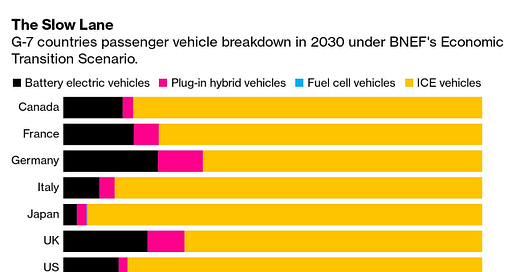Japan Falls Short of G7 Peers
Japan's Laggard Approach to Decarbonization: Assessing its Impact on the G7's Pledge to Mitigate Climate Change
The Group of Seven (G7) has positioned itself as a leader in the global mission to decarbonize. However, while they may have good intentions, their actions do not necessarily match their words. According to the nonprofit Climate Action Tracker, no G-7 country has made pledges to the United Nations that are sufficient to keep the world from warming less than 1.5 degrees Celsius from pre-industrial levels. Despite their outsize contribution to the planet-warming carbon dioxide that’s accumulated in the atmosphere, the G7 is falling short of what’s needed to reach net zero by 2050.
One member of the group stands out as a laggard: Japan. Despite being one of the world's largest carbon emitters and having a significant role to play in preventing catastrophic climate change, Japan's current emissions reduction plan is not aligned with the goal of achieving net-zero emissions by 2050. The country's reluctance to move away from carbon-intensive energy sources is reflected in draft communique documents circulated ahead of the G-7 energy and environment ministers summit in Sapporo. Japan, along with the EU and the US, expressed reservations about setting a 2030 deadline to phase out unabated domestic coal power.
Japan's plan to eliminate carbon pollution from its power sector relies heavily on carbon capture, ammonia, and hydrogen to keep burning fossil fuels. This approach is unique among the G7, and it highlights Japan's reluctance to transition away from carbon-intensive energy sources. Japan is also working toward meeting a target for all new passenger car sales to be electric vehicles by 2035. However, policies mandating the long-term phase-out of internal combustion engine vehicles have faced pushback from Toyota Motor Corp.
Japan's current emissions-reduction trajectory is far from what's needed to reach net zero by 2050. According to an analysis by BloombergNEF, Japan had the lowest share of zero-carbon power generation in the G7 in 2021 and is projected to have the second-lowest after Italy by the end of the decade. Additionally, Japan needs a more modern power grid that can more easily accept renewable power and distribute those electrons where they are required. The country estimates it will spend between 3.6 and 5.4 trillion yen ($27 and $41 billion) through midcentury to boost interregional transmission. While this will help, the government still envisions renewables only making up around 50% of the nation’s power generation by 2050.
While the recent G7 meeting in Sapporo, Japan was a positive step towards the shift to cleaner, renewable energy, it still falls short of what is needed to mitigate the effects of climate change. The G7 leaders' pledge to reduce carbon emissions and achieve a predominantly decarbonized power sector leaves risks about not doing enough for climate urgency. Moreover, while Japan's emphasis on clean coal, hydrogen, and nuclear energy may be a step in the right direction, it is still a controversial approach to decarbonization. For example, BNEF estimates that even if Japan manages to develop facilities that can capture 240 million tons of carbon dioxide per year by 2050, it would only account for about a quarter of the country's total emissions in 2020. Without bold and decisive action, the world will continue to face the catastrophic effects of climate change, including extreme weather events, rising sea levels, and widespread environmental degradation.




